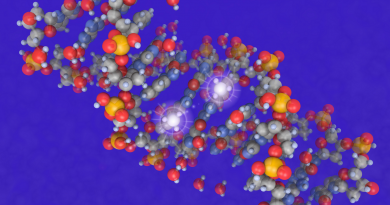Repurposed credit card-sized technology improves and broadens use of diagnostic stool tests
 A patient with gastrointestinal problems pays her doctor a visit. The doctor orders a stool test that will measure fecal bile acids, compounds made by the liver that can also be modified by the intestinal microbiome and are known for facilitating digestion and absorption of lipids or fats in the small intestine.
A patient with gastrointestinal problems pays her doctor a visit. The doctor orders a stool test that will measure fecal bile acids, compounds made by the liver that can also be modified by the intestinal microbiome and are known for facilitating digestion and absorption of lipids or fats in the small intestine.
Bile acid profiles are altered in several gastrointestinal conditions, including irritable bowel syndrome, Crohn’s disease, and several forms of diarrhea, colitis and some bacterial infections. The doctor hopes that the results of the stool test will help identify the root cause of the patient’s condition and provide clues about the best approach to treat the illness.
The stool sample is collected and processed, and if the point of collection differs from the analytical testing site where bioanalysis is to be performed, then the sample is stored frozen at -80°C to prevent degradation until it can be shipped frozen on dry ice. These types of stool sample-based bioanalyses are typically performed using quantitative tandem mass spectrometry, the most accurate, sensitive and specific method for the measurement of fecal bile acids today.
The complex, multistep process described above can be a significant barrier for remote clinical locations, for samples collected after the analytical lab’s working hours or for sample collections in resource-limited settings or extreme environments.

“We wanted to generate technology that could be used anywhere in the world and didn’t require complex storage conditions,” said first author of the study presented here, Dr. Melinda A. Engevik, assistant professor of regenerative medicine and cell biology at Medical University of South Carolina.


“The solution grew naturally from a long-term professional relationship between my lab, which is interested in studying metabolic products produced by microorganisms, and that of Dr. Donald Chace, principal scientist at Capitainer, who developed the mass spectrometry analysis of blood compounds that is used worldwide to screen newborns for dozens of rare genetic diseases. He has worked for more than 30 years with the dried blood spot (DBS) technology used for newborn screening,” said co-corresponding author Dr. Thomas D. Horvath, instructor of pathology and immunology at Baylor College of Medicine and Texas Children’s Hospital.
DBS technology is an efficient, practical method to collect blood samples and transport them in a simple and safe manner to a laboratory for analysis. The blood is collected and dried on a special paper on a support the size of a credit card, creating a dried blood spot. Then, the sample is sealed and shipped at ambient temperature in an envelope. Once in the lab, the sample is extracted from the paper and analyzed using mass spectrometry methods. This system also avoids the biohazard precautions associated with transporting a liquid blood sample.
It was a natural progression to investigate whether DBS could be repurposed to simplify the collection, transport and analysis of other bodily fluids. In the current study, we investigated whether dried fecal spots (DFS) could be used to measure fecal bile acids,” Chace said.
C. difficile bacterial infections are associated with large shifts in the bile acid profiles, therefore Engevik in South Carolina collected fecal samples from individuals infected with these bacteria as well as samples from healthy individuals and individuals with diarrhea. Engevik processed the samples, placed them in DFS paper cards and let them dry. The sealed cards were shipped at ambient temperature to Horvath’s lab in Houston. “We did not use dry ice and bulky containers for storage and shipping,” Engevik said.
The researchers kept the samples at room temperature in Horvath’s lab for four months. After that, they analyzed the bile acid content in the DFS samples and compared the results with reference “liquid-state” sample extracts that had been stored at -80°C during the same four-month time span.

“We were very excited when the results showed no significant differences in the amount of bile acids in both the DFS and the frozen fecal samples,” Horvath said.
These findings proved the concept that DFS provides reliable results on bile acid content in fecal samples that are comparable to those obtained with the traditional method, but offer the advantages of easier storage and shipping, reduced cost and improved safety.”
“I think this work has the potential to change how samples are processed in remote settings, and this has huge global implications,” Engevik said. “For instance, scientists conducting research work in the field or physicians attending patients in remote areas could collect fecal samples using the DFS cards, store them in an envelope and carry the samples without having to freeze them until they arrive in their lab for analysis, even months later.”
“We also visualize DFS as a system that allows people to collect fecal samples from their own home and then mail the card to the analytical lab, saving them a trip to the doctor’s office,” Horvath said.
“Now that we know that our system can accurately measure bile acids, we are excited about measuring other fecal compounds as well as those produced by microorganisms,” Chace said.
The study is published in the American Journal of Physiology – Gastrointestinal and Liver Physiology.
Santosh Thapa, Ian M Lillie, Mary Beth Yacyshyn, Bruce Yacyshyn Andrew J. Percy also contributed to this work. The authors are associated with one or more of the following institutions: Baylor College of Medicine, Texas Children’s Hospital, Medical University of South Carolina at Charleston, Cornell University, University of Cincinnati College of Medicine, Cambridge Isotope Laboratories, Inc., and Capitainer.
This study was supported by National Institutes of Health Grant K01K123195-01.
Follow From the Labs on X @BCMFromtheLabs and Instagram!



